全文HTML
--> --> -->为解决同时满足高时空分辨和高探测效率这一难题, 阵列型成像屏被提出研究, 在不改变的空间分辨的前提下, 通过加大阵列的厚度进一步提高探测效率. 国外研究者针对惯性约束聚变中子图像诊断需求, 对闪烁纤维屏和毛细管液闪阵列屏先后做了大量研究, 其像元尺寸从毫米到几十微米量级. 由于闪烁纤维的工艺技术限制, 单像元小于0.2 mm闪烁纤维阵列屏难以实现, 国外研究者通过石英毛细管液闪阵列, 使得单像元尺寸达到了65 μm, 并用于国家点火装置诊断中[15-17]. 国内对闪烁纤维阵列屏研究相对较多, 目前还未见石英毛细管液闪阵列屏的详细报道. 由于超细石英毛细管加工、排列和液闪均匀灌封等都存在极大难度, 成品率低, 国外的成品对国内禁运, 难以购得. 为此自主开发了一种像元为0.1 mm的新型液闪阵列屏, 本文对该阵列屏从理论和实验两方面开展空间分辨特性研究, 并与常见的几种国产闪烁纤维屏进行比较, 研究结果表明研制的新型液闪阵列屏具有好的空间分辨能力. 该阵列屏的成功研制为提升射线图像探测水平提供了有益探索.
 图 1 阵列成像屏实物图 (a) LCA液闪阵列屏; (b) GSFA纤维屏; (c) BSFA纤维屏
图 1 阵列成像屏实物图 (a) LCA液闪阵列屏; (b) GSFA纤维屏; (c) BSFA纤维屏Figure1. Array imaging plate: (a) LCA liquid scintillator capillaries array; (b) GSFA scintillating array screen; (c) BSFA scintillating array screen.
| 阵列图像屏 | |||
| GSFA | BSFA | LCA | |
| 像元尺寸/mm | 0.3 | 0.5 | 0.1 |
| 中心波长/nm | 492 | 432 | 426 |
| 衰减时间/ns | 2.7 | 2.7 | < 3.5 |
| 厚度/mm | 50 | 50 | 60 |
| 闪烁材料 | BCF20 | BCF10 | EJ309 |
表1三种阵列屏的基本结构尺寸和参数
Table1.Geometry dimension and performance parameter of three array imaging plate.
其中GSFA是采用BCF-20闪烁纤维排列而成的阵列屏, BSFA为BCF-10闪烁纤维阵列屏, LCA为内径是0.1 mm、壁厚为0.02 mm的石英毛细管液闪阵列屏, 其毛细管中装有高发光效率EJ309液体闪烁体. 液闪和闪烁纤维都是有机闪烁材料, 主要的成分是碳和氢.
把内径仅0.1 mm的石英毛细管排成大尺寸均匀的阵列屏, 其研制、加工难度非常大, 加工过程较为复杂. 超细毛细管在拉制过程易破碎, 即使不破碎也容易变形, 拉制过程需精确控制. 为防止破碎和形变, 加工过程中需在毛细管内鼓入适当空气并严格控制气量, 同时要采用“倒吸法”消除碎屑, 防止毛细管堵塞. 在液闪灌装之前, 要通过晶须生长法对毛细管内壁进行粗糙化处理, 实现液闪在毛细管内均匀浸润, 同时为保真阵列屏的性能稳定, 还要对毛细管壁进行去活性分子团和惰性化处理. 在灌装液闪过程中, 毛细管内容易产生气泡, 需进一步采用“微正压慢渗透”工艺进行排气. 灌装液闪后的阵列屏两端由光纤面板进行密封.
调制传递函数(modulation transfer function, MTF)常用来表征成像系统的空间分辨特性[20], 本文借鉴光电成像器件MTF的测试原理, 建立了模拟分析方法和实验研究方案, 对射线激发下的阵列成像屏开展空间分辨特性研究.
2
3.1.MTF理论模拟方法
刀口边缘响应法是获得成像器件MTF常用的一种方法, 即先获得成像器件对刀口响应的边缘扩展函数(edge spread function, ESF), 然后对ESF进行微分和傅里叶变换得到MTF. 对离散采样阵列探测器, 为更全面评估空间分辨能力, 应用倾斜边缘刀口法[21]. 基于该方法, 本文采用大型的射线粒子输运模拟软件MCNPx进行仿真模拟, 该软件对粒子输运模拟过程比较接近真实的物理过程.本文模拟中射线源(分别是14 MeV中子和1.25 MeV伽马)设计为一均匀定向发射的面源, 面源的形状为矩形, 发射方向垂直于阵列屏入射面. 由于面源边沿与阵列的相对位置(见图2(a)—(c))对能量沉积分布和荧光输出分布均会有影响, 为此采用倾斜边缘刀口法, 见图2(d)的方式, 即面源在阵列屏上的投影边沿与阵列排布方向呈一定夹角. 夹角的设计规则是沿着倾斜的边沿, 每经过10个像元, 第一个像元未被辐照, 而最后一个恰好被完全辐照, 则根据几何关系算得倾斜角度约为6°. 模拟中各阵列屏的结构参数见表1. 采用MCNPx软件中F6计数卡记录每根阵列单元内次级带电粒子(电子或质子)的能量沉积, 再根据闪烁材料对不同能量带电粒子(电子或质子)的光响应函数, 累计得到每个像元内产生的荧光光子数, 根据图3及下列的(1)式和(2)式可求得阵列成像屏的ESF.
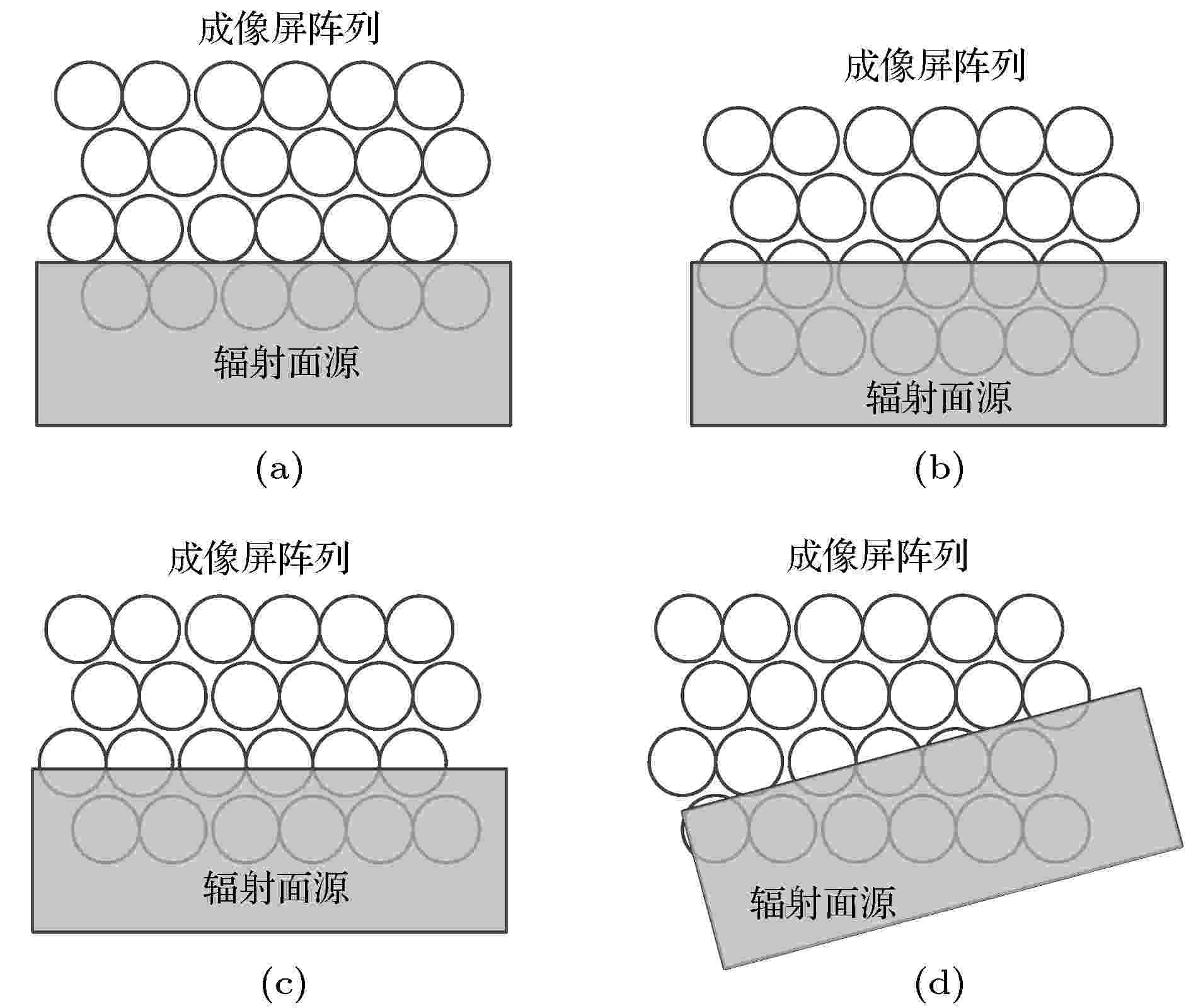 图 2 矩形面源在阵列上的投影示意图 (a)面源投影内的阵列单元完全被辐照; (b), (c)投影边界处的阵列单元没有被完全辐照; (d)投影倾斜于阵列排布方向
图 2 矩形面源在阵列上的投影示意图 (a)面源投影内的阵列单元完全被辐照; (b), (c)投影边界处的阵列单元没有被完全辐照; (d)投影倾斜于阵列排布方向Figure2. Projection sketch of surface source on the array: (a) The array cell at the boundary of projection area is fully irradiated; (b), (c) the array cell at the boundary of projection area is not fully irradiated; (d) edge of projection slants through the horizontal direction of the array.
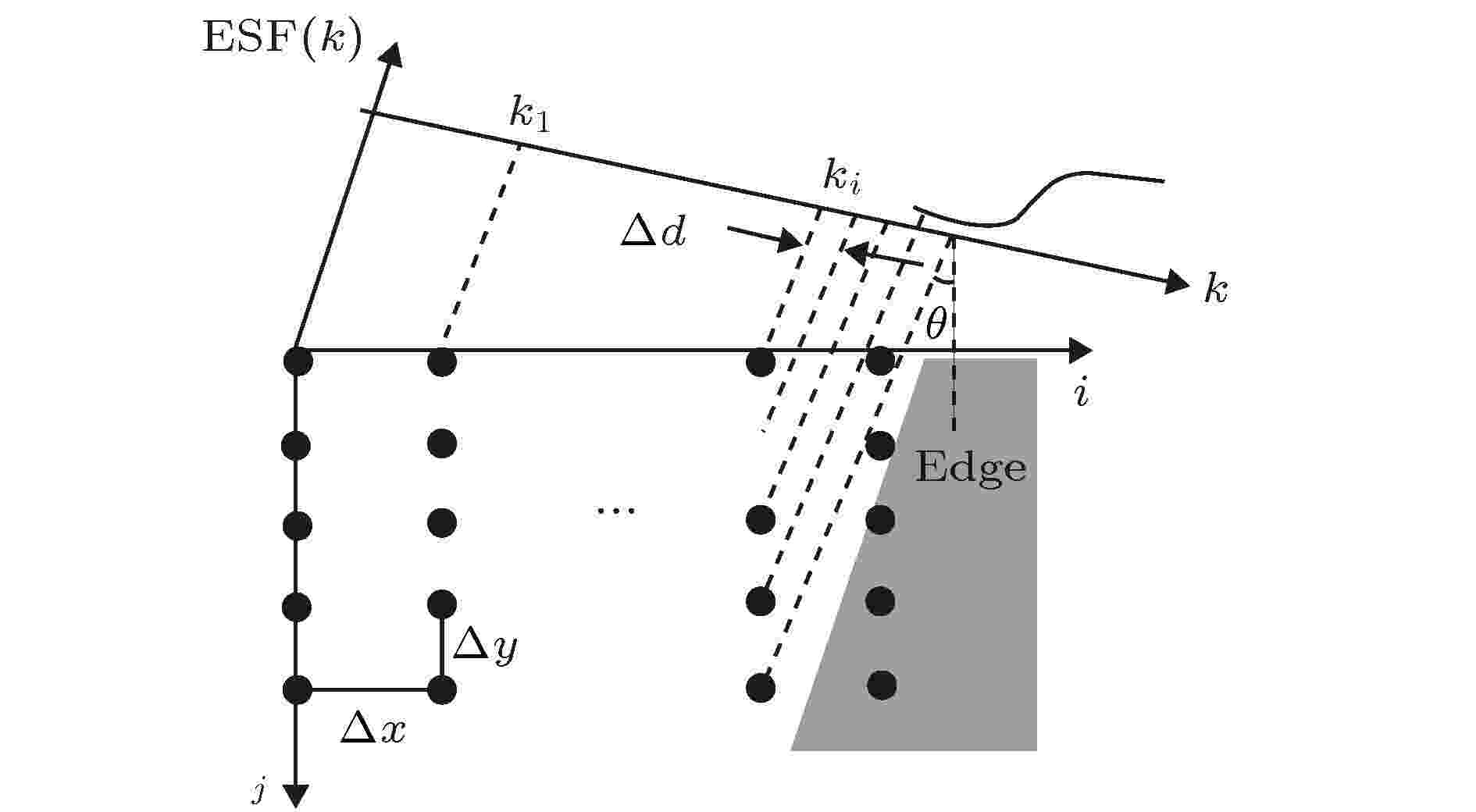 图 3 倾斜边缘扩展函数投影示意图
图 3 倾斜边缘扩展函数投影示意图Figure3. Projection sketch of slope edge for ESF.
边缘扩展函数是沿垂直于边缘方向的投影曲线. 对于倾斜边缘, 其边缘图像与采样阵列方向存在一定夹角, 见图3. 由图像的几何关系得到倾斜边缘的ESF表达式为








根据文献[21, 22]方法, 可采用(2)式的迭代计算得到ESF.
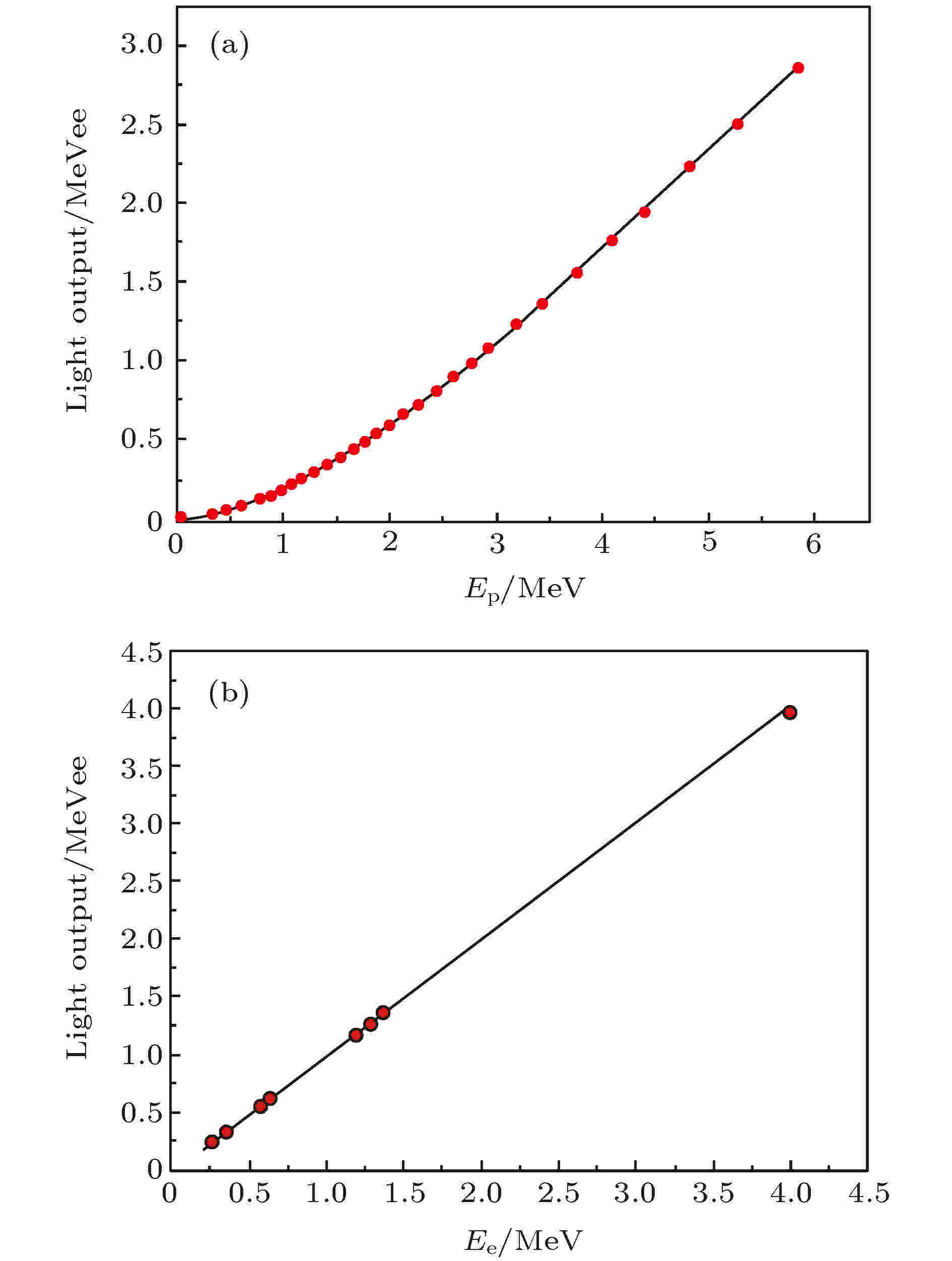 图 4 EJ309液闪对质子和电子的光响应曲线(1 MeVee表示沉积1 MeV电子能量的输出光量;) (a)质子光响应函数; (b)电子光响应函数
图 4 EJ309液闪对质子和电子的光响应曲线(1 MeVee表示沉积1 MeV电子能量的输出光量;) (a)质子光响应函数; (b)电子光响应函数Figure4. Light output of EJ309 as a function of energy for particle energy: (a) Light output as a function proton energy; (b) light output as a function electron energy.
2
3.2.MTF模拟结果与分析
由3.1节描述的方法结合图4的光响应曲线, 就可以模拟给出阵列屏在射线激发下的ESF. 图5是液闪阵列屏在14 MeV中子和1.25 MeV 伽马激发下ESF下降沿的归一化光输出分布曲线. 图中以沿垂直于边缘方向依次排列的毛细管序号为横坐标, 边缘处被直照的毛细管为第1个像素(pixel), 边缘外依次为第2个像素, 一直到第n个像素. 各毛细管内相对光输出为纵坐标. 从图5曲线上可知, 由于射线散射及产生次级粒子的能量沉积弥散, 不仅在射线直接照射的毛细管内有光输出, 在未被照射的相邻毛细管内均出现了光输出, 相距越远, 光输出越少. 对于1.25 MeV伽马射线, 由于其作用产生的次级电子穿透能力较强, 光输出在更远的毛细管内产生, ESF的下降沿更缓. 对比说明, 液闪阵列屏对14 MeV中子空间分辨要好于1.25 MeV伽马射线.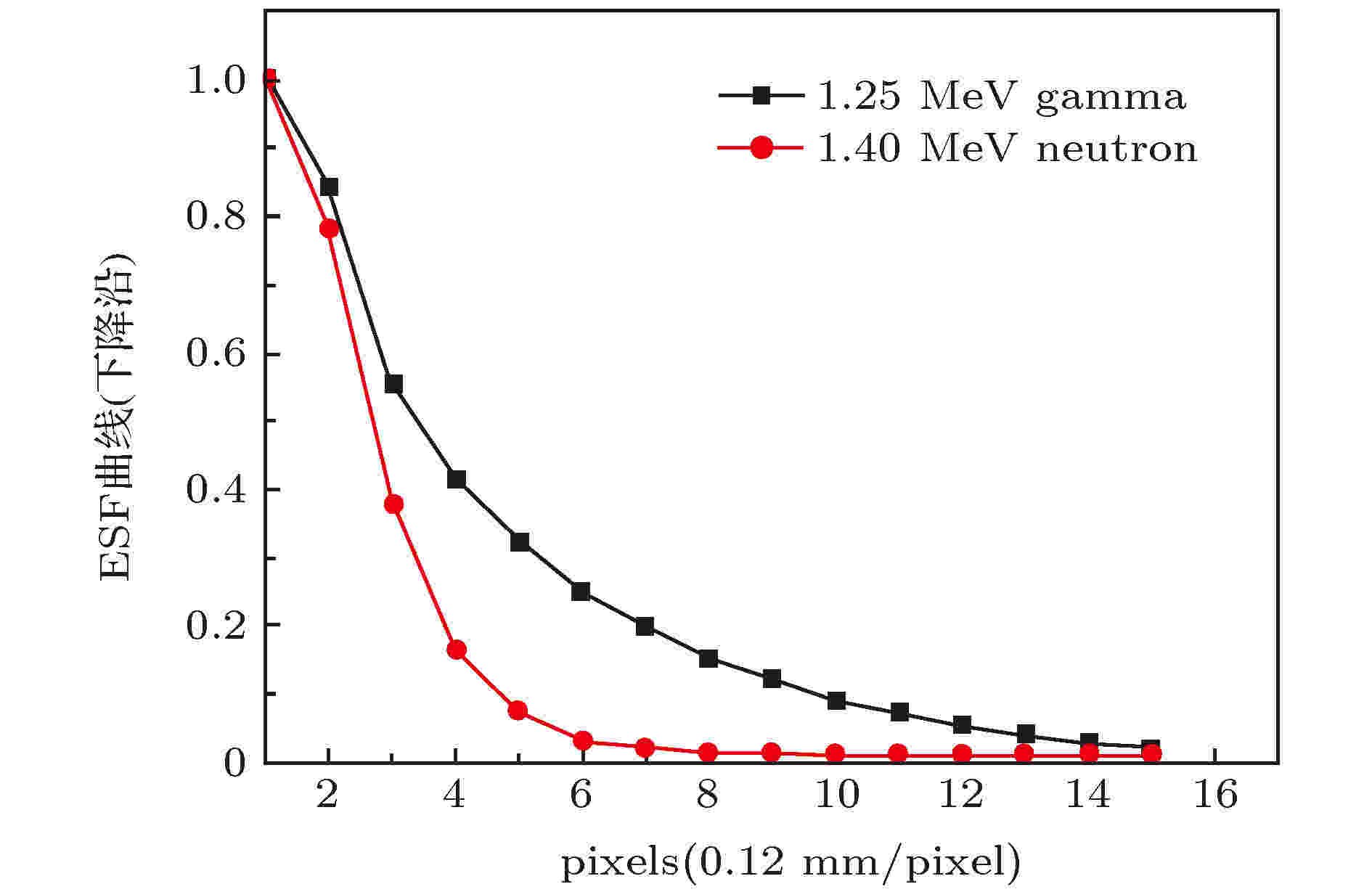 图 5 模拟的液闪阵列屏ESF下降沿归一化曲线
图 5 模拟的液闪阵列屏ESF下降沿归一化曲线Figure5. Normalized curves of falling edge of ESF for liquid scintillator array by simulation.
采用上述模拟方法, 分别对液闪阵列屏和闪烁纤维阵列屏开展了MTF理论模拟. 图6是模拟的结果, 标注SFA的是闪烁纤维阵列屏, 标注LCA的是液闪毛细管阵列屏. 从图6可知, 不论是对中子还是对伽马射线, 随着闪烁纤维直径的减小, 空间分辨能力改善. 对于14 MeV中子, 闪烁纤维直径由0.5 mm降低到0.1 mm, 在MTF值为0.1处, 空间分辨从0.9 lp·mm–1提高到了1.4 lp·mm–1, 而0.1 mm直径毛细管的液闪阵列屏空间分辨达到1.8 lp·mm–1; 对于1.25 MeV伽马, 闪烁纤维直径由0.5 mm降低到0.1 mm, 在MTF值为0.1处, 空间分辨从不足0.5 lp·mm–1提高到近0.7 lp·mm–1, 而液闪阵列屏达到0.9 lp·mm–1, 仍优于闪烁纤维屏.
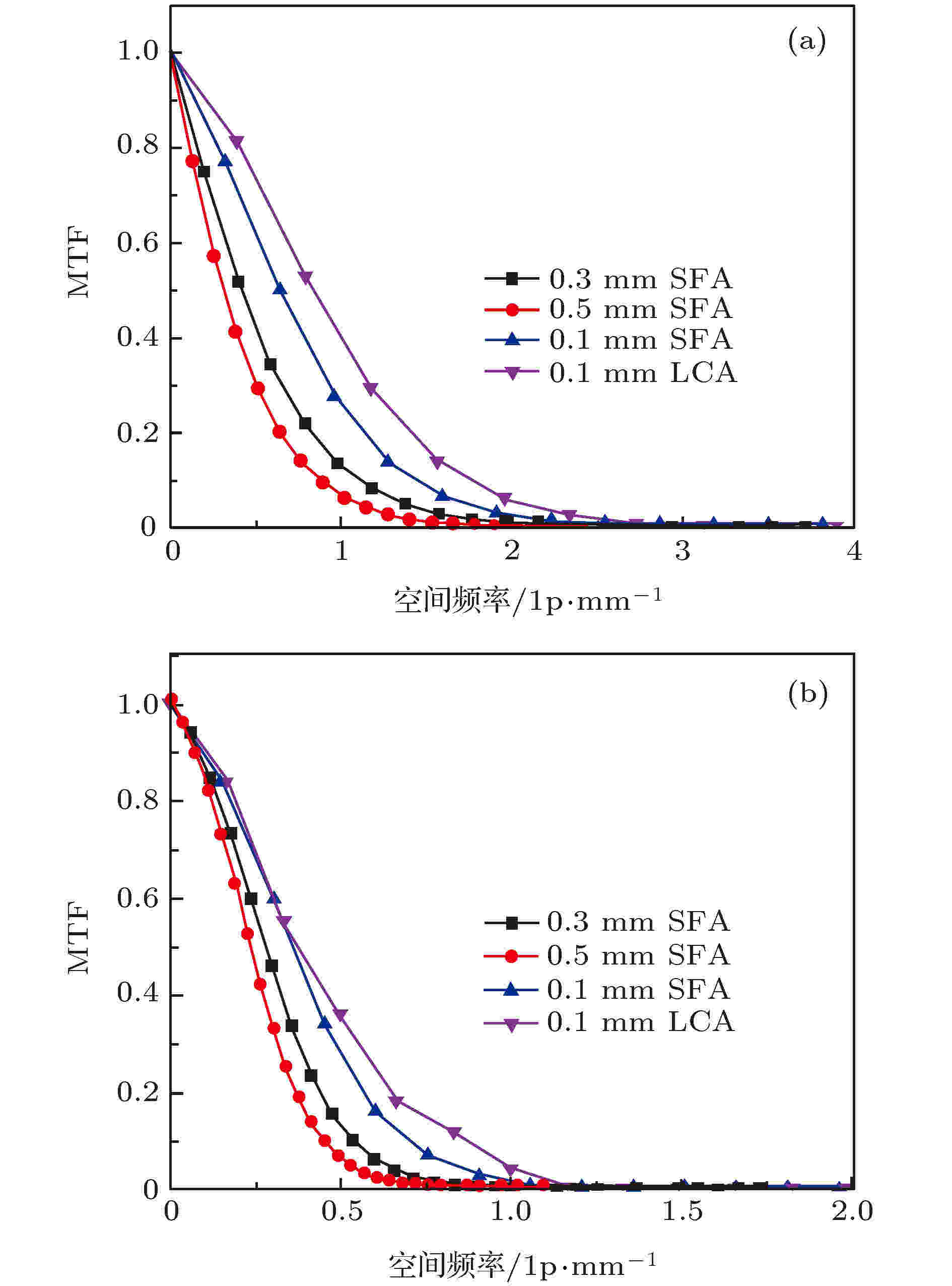 图 6 新型液闪阵列屏与闪烁纤维屏的MTF理论模拟曲线 (a) 14 MeV中子激发下的MTF曲线; (b) 1.25 MeV伽马激发下的MTF曲线
图 6 新型液闪阵列屏与闪烁纤维屏的MTF理论模拟曲线 (a) 14 MeV中子激发下的MTF曲线; (b) 1.25 MeV伽马激发下的MTF曲线Figure6. MTF curves of the liquid scintillator capillary array and scintillating fiber array by simulation: (a) MTF curves of the three array image plates with 14 MeV neutron irradiation; (b) MTF curves of the three array image plates with 1.25 MeV Gamma irradiation.
由射线与物质的作用机制可知, 石英材料对质子阻止能力优于有机材料, 而且毛细管壁的厚度大于闪烁纤维的包层, 相比闪烁纤维阵列, 质子在石英阵列内串扰更小, 能量沉积弥散更小, 空间分辨性能更好. 但对于射程较长的电子来说, 两种包层材料对电子阻止作用相差并不大, 因此相同像元尺寸的纤维阵列屏和液闪阵列屏, 对1.25 MeV伽马射线的空间分辨差异没有对14 MeV中子的差异大(见图6(a)和图6(b)对比), 模拟结果符合理论预期.
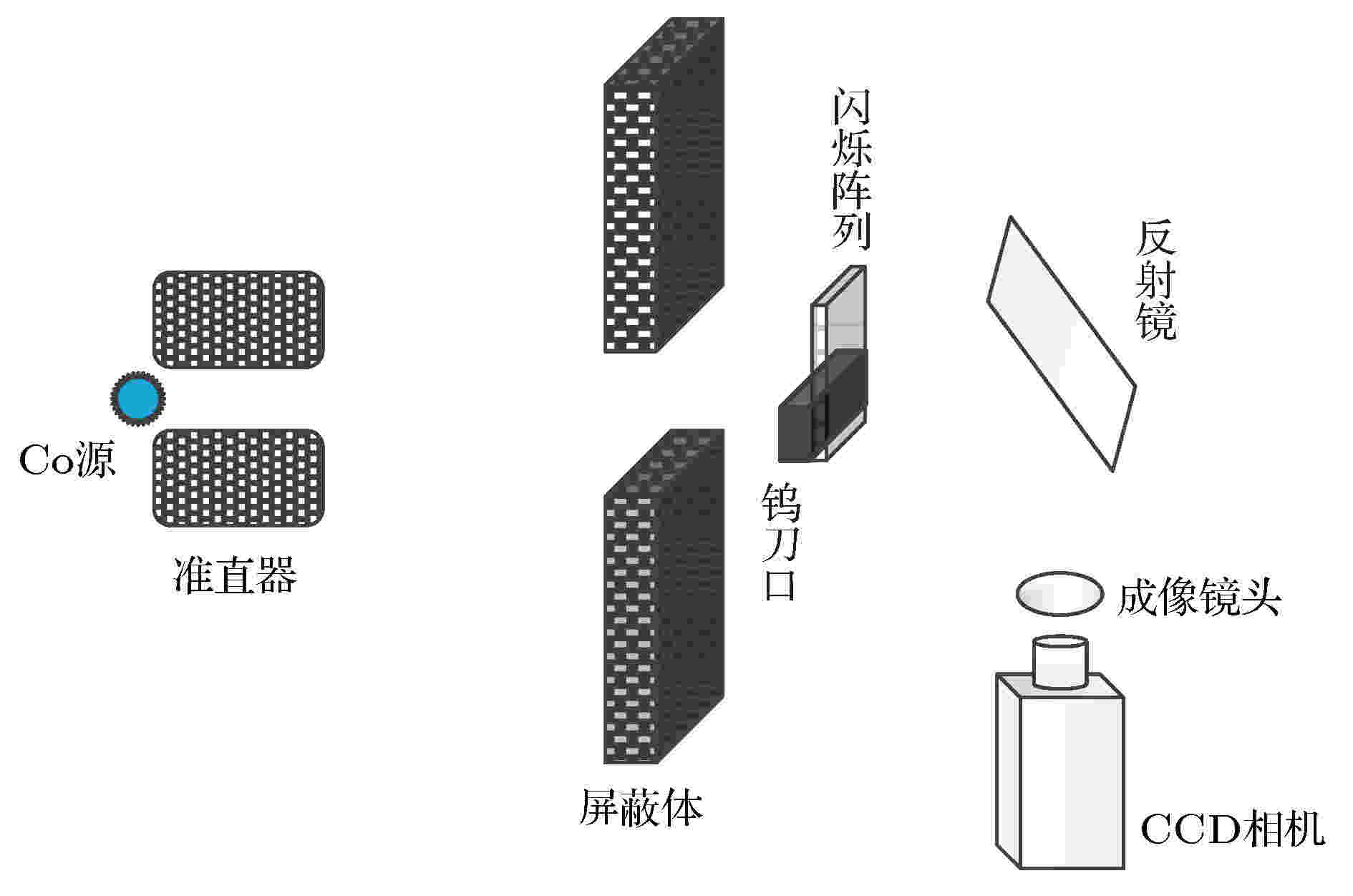 图 7 成像屏调制传递函数测量布局示意图
图 7 成像屏调制传递函数测量布局示意图Figure7. Experimental setup sketch for MTF measurement.
首先对阵列屏的均匀性进行测量, 均匀性不仅是衡量成像屏质量的重要参数, 也是图像数据处理中灰度校正需要标定的参数, 经过成像屏均匀性校准才能得到更准确的数据, 即所谓图像的平场响应校准. 测点处射线的空间分布均匀性和相机系统的成像均匀性好于97%. 图8(a)—(c)分别是液闪阵列屏和其他两种屏均匀性的实测结果. 直观地从图像灰度分布看, 液闪阵列屏均匀性明显好于闪烁纤维屏.
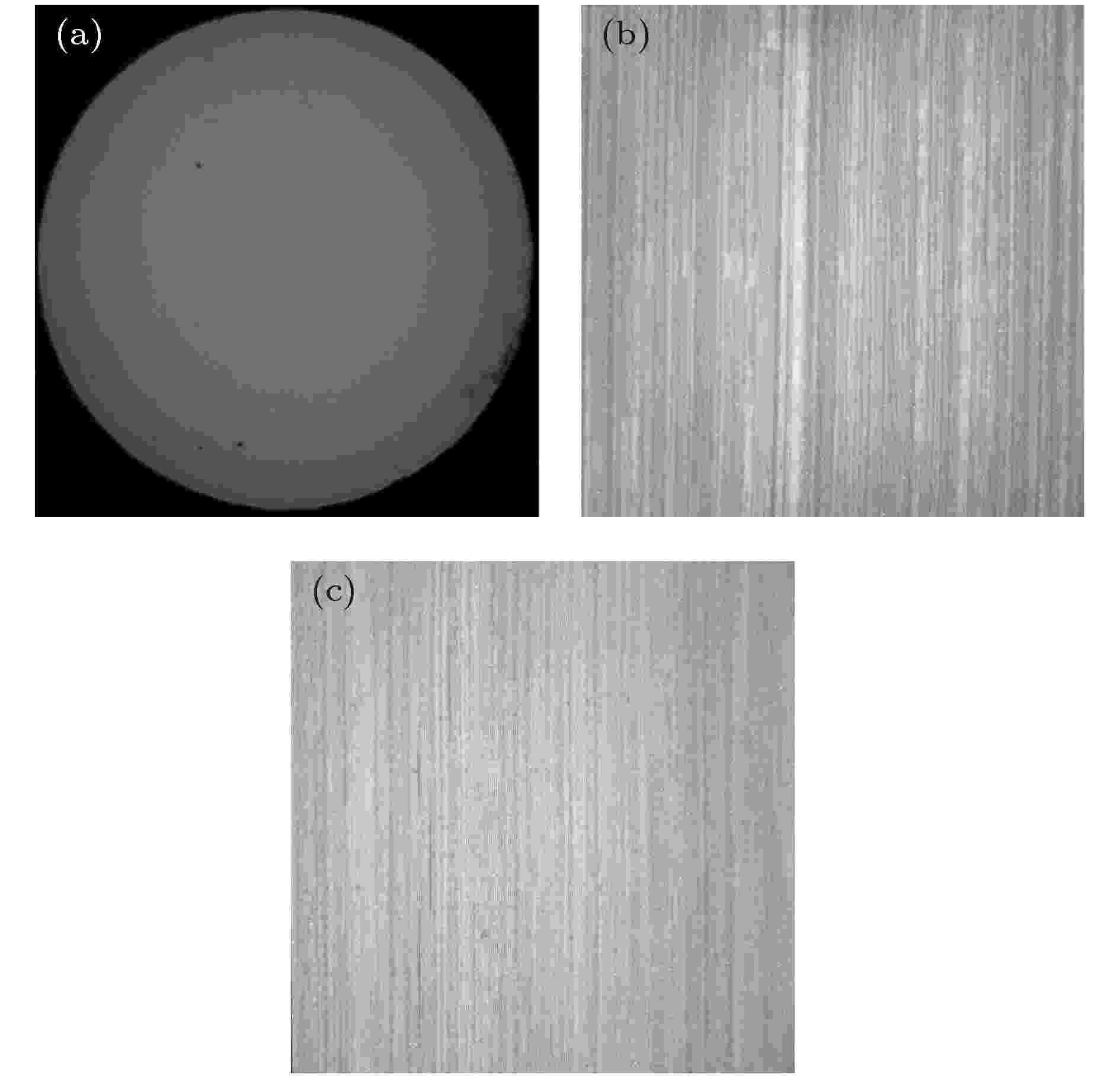 图 8 三种成像屏均匀性的实测结果 (a) LCA液闪阵列; (b) GSFA纤维阵列屏; (c) BSFA纤维阵列屏
图 8 三种成像屏均匀性的实测结果 (a) LCA液闪阵列; (b) GSFA纤维阵列屏; (c) BSFA纤维阵列屏Figure8. Luminescent uniformity of the three array image plates by measurement: (a) LCA liquid scintillator capillaries array; (b) GSFA scintillating fiber array; (c) BSFA scintillating fiber array.
图9(a)—(c)分别是在伽马射线源上实测的液闪阵列屏和两种闪烁纤维阵列屏的MTF曲线, 对比可见, 液闪阵列有更好的空间分辨, 在MTF值为0.1处, 液闪阵列的空间分辨接近0.9 lp·mm–1, 像元0.3和0.5 mm的闪烁纤维阵列空间分辨均没有超过0.5 lp·mm–1. 由图9所示实验和理论模拟结果可看出, 模拟得到曲线和实验测量曲线基本一致, 实验测得的MTF曲线值较理论模拟的略小, 这可能是由于实际的射线源并非理想的点源, 受到源几何尺寸的影响.
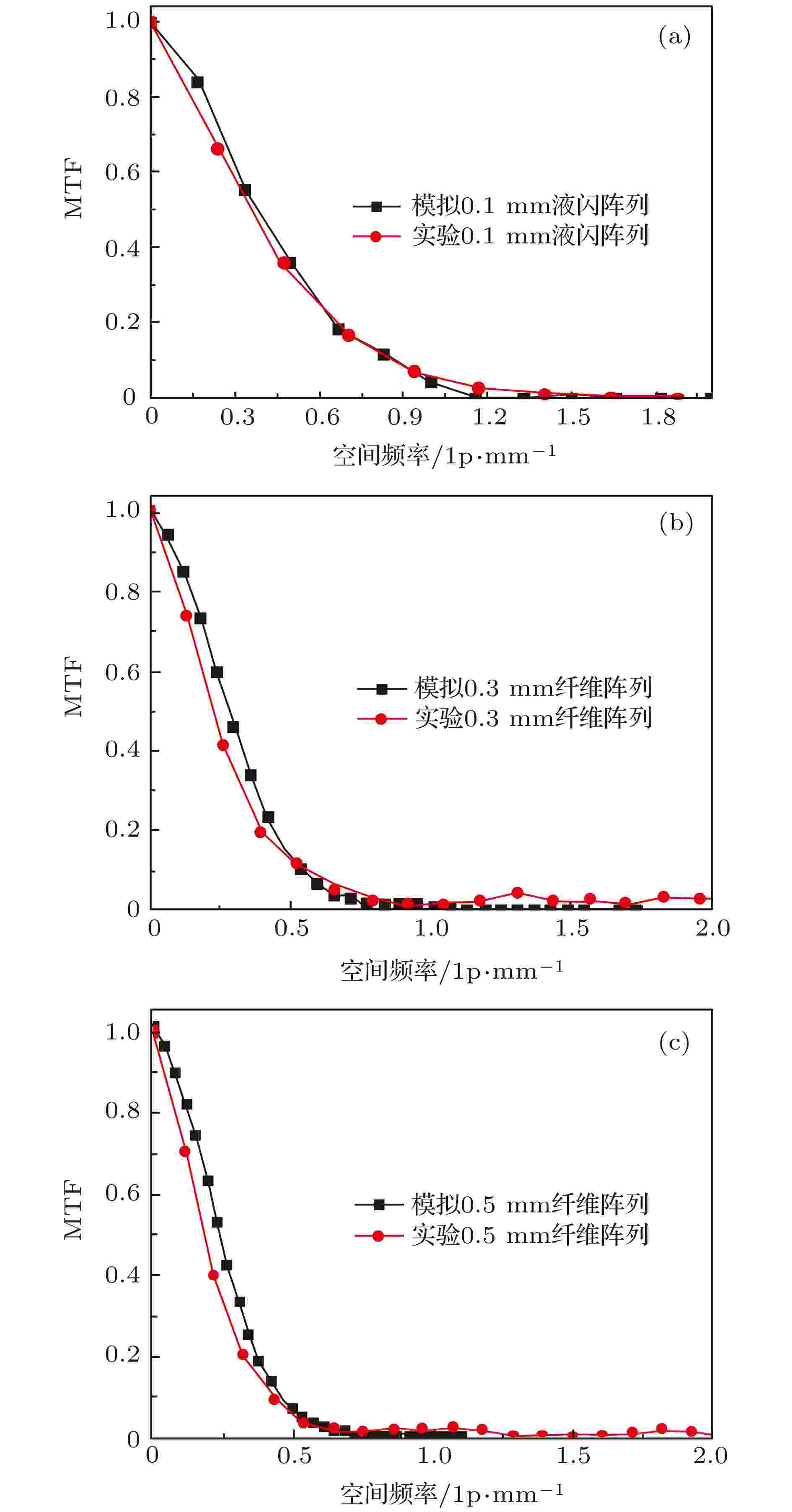 图 9 阵列屏对1.25 MeV伽马射线的MTF实测与模拟结果 (a) LCA液闪阵列屏; (b) GSFA闪烁纤维阵列屏; (c) BSFA闪烁纤维阵列屏
图 9 阵列屏对1.25 MeV伽马射线的MTF实测与模拟结果 (a) LCA液闪阵列屏; (b) GSFA闪烁纤维阵列屏; (c) BSFA闪烁纤维阵列屏Figure9. Comparison of MTF curves measured and simulated for the three array image plates under 1.25 MeV Gamma ray: (a) LCA liquid scintillator capillaries array; (b) GSFA scintillating fiber array; (c) BSFA scintillating fiber array.
国内现有的14 MeV中子源强度都较低, 比文中所用的钴源强度低近2个量级, 还不能满足阵列屏对14 MeV中子的MTF测量, 通过伽马射线的实验研究表明上述理论模拟方法是可行的, 模拟结果也是可信的. 故通过理论模拟得到的阵列屏对14 MeV中子的MTF曲线, 可以用来表征其实际的空间分辨特性.
感谢合肥正阳光电科技有限公司刘杰为液闪阵列屏研制所给予的帮助, 感谢西北核技术研究院马燕助理研究员给予实验上的支持.
